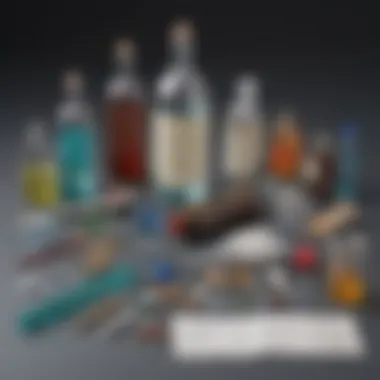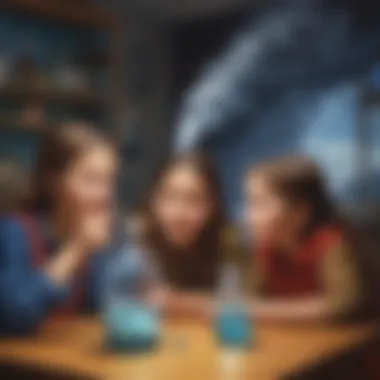Exploring the Tornado in a Bottle Experiment


Intro
The tornado in a bottle experiment serves as a captivating demonstration of fluid dynamics and vortex formation. Not only does it engage youthful minds with interactive learning, but it also elucidates complex scientific principles in an accessible manner. By creating a miniature tornado, participants can observe firsthand the dynamics of swirling fluids. This activity is more than just play; it enhances comprehension of physical forces and encourages curious exploration of the natural world.
Science Fun Facts
Learning about tornadoes can be exciting when paired with fun facts. Here are some intriguing snippets:
- Tornadoes are essentially violent rotating columns of air. They form under specific meteorological conditions, often during severe thunderstorms.
- Did you know that the strongest tornado can produce winds exceeding 300 mph? This sort of tornado is classified as an EF5, and it can cause significant destruction.
- Tornadoes can occur on every continent except Antarctica. They are most common in the United States, particularly in an area known as "Tornado Alley."
"Understanding tornado dynamics can prepare us for real-life weather events while also sparking curiosity in young minds."
This experiment serves as a practical mechanism to understand these potentially dangerous weather phenomena in a controlled environment.
Discover the Wonders of Science
Engagement with scientific concepts is more than rote memorization of facts; it's about meaningful exploration.
- Exploring Various Scientific Concepts: The tornado in a bottle experiment teaches students about inertia, centripetal force, and the properties of water. Experiments like these lay foundational knowledge for further scientific inquiry.
- Educational Videos and Animations: Visual content related to vortex formation can complement the hands-on experience. Videos illustrate concepts like pressure gradients effectively.
- Interactive Learning Tools: Online platforms offer simulations of tornado formation, providing alternate insights. These tools can personalize learning experiences.
- Real-Life Applications of Science: Understanding fluid dynamics holds importance beyond experiments. Engineers use these principles in designing drainage systems and predicting weather patterns.
Science Quiz Time
To solidify understanding, engaging quizzes can be valuable. Here are examples of interactive quiz formats that will challenge young learners:
- Multiple Choice Questions: What is the primary factor in tornado formation?
- Brain Teasers: Can you solve a puzzle related to the speed of tornado winds?
- Learning Through Gamification: Students can earn points or badges to encourage participation in these quizzes, making learning a fun experience.
Science Experiment Showcase
Creating a tornado in a bottle requires simple materials and a systematic approach:
- Fun and Engaging Experiments: This experiment is not only educational but also a visual delight. Children are likely to be captivated by the swirling effects.
- Step-by-Step Instructions:
- Materials List: Two 1-liter plastic bottles, a connector (like duct tape), and water are necessary for conducting this experiment.
- Safety Tips and Precautions: Always supervise young participants to prevent spills or mishaps. Ensure the materials used are safe and appropriate for the age group involved.
- Gather two plastic bottles, some water, and a connector.
- Fill one bottle almost to the top with water.
- Connect the two bottles upside down.
- Swirl the top bottle gently to initiate the vortex and observe.
Intro to the Tornado in a Bottle
The tornado in a bottle experiment provides an intuitive approach to understanding complex scientific principles such as fluid dynamics and vortex formation. This topic is particularly relevant for young, inquisitive minds. Through hands-on activities, children can visualize scientific concepts in a tangible way. Such experiments foster curiosity and encourage further exploration in science.
What Is a Tornado?
A tornado is a rapidly rotating column of air that extends from a thunderstorm to the ground. It is driven by severe weather conditions, often during thunderstorms. Tornadoes can occur in various shapes and sizes, and their formation involves several atmospheric phenomena. The most powerful tornadoes can cause significant damage, making it essential to understand the science behind them for both safety and educational purposes.
Understanding tornadoes involves elements like wind shear, which is the change in wind speed and direction at different altitudes. As warm air rises and cool air sinks, their interaction with varying pressures leads to the formation of a rotating system. This system can develop into a tornado under certain conditions.
The Science of Vortex Formation
Vortex formation is a fundamental concept in fluid dynamics. A vortex is a flow pattern where fluid moves in a circular motion around an axis. This motion can be observed in several everyday situations, such as when water drains from a bathtub or when a cyclone develops in the atmosphere.
In the tornado in a bottle experiment, participants can see how the movement of water creates a whirlpool effect that mimics a tornado. The transition from a straight flow to a circular motion illustrates the principles of angular momentum and pressure differentials in a simplified manner.
By observing this phenomenon, children learn not only about vortex formation but also about the broader implications of fluid dynamics in nature. Such experiments help to demystify complex scientific concepts, making them more accessible and relatable.
Purpose of the Experiment


The purpose of the tornado in a bottle experiment extends beyond mere curiosity. It serves as a gateway for understanding complex scientific principles such as fluid dynamics and vortex motion. The act of creating a vortex exemplifies real-world phenomena, engaging learners in a hands-on exploration of movement within liquids and gases. By conducting this experiment, participants can uniquely visualize how forces interplay in the natural world.
Demonstrating Fluid Dynamics
Fluid dynamics is the study of how fluids behave when they move. In the tornado in a bottle experiment, this concept is made tangible. When water is swirled in a circular motion, it forms a vortex—a phenomenon closely resembling how tornadoes function in nature. This experiment provides an excellent opportunity to illustrate concepts like flow patterns, velocity, and pressure. Children can witness firsthand how water behaves differently when spun versus remaining still. Such observations help solidify foundational knowledge in physics and engineering principles.
Key points to consider:
- Visual Learning: Seeing the vortex formation allows for a better grasp of complex ideas.
- Practical Application: Knowledge gained can apply to understanding weather patterns and engineering designs.
- Experimentation: It encourages adjustments in water levels or bottle sizes to observe changes, fostering critical thinking.
Engaging Young Minds
Engagement is crucial in an educational setting. Children often learn best when they can connect with the material. This experiment offers excitement and curiosity. The act of creating a tornado in a bottle captivates attention and holds it through observation and active participation. Parents and educators can use this activity to spark discussions regarding natural disasters or fluid motion, transforming it into a learning experience that extends beyond the experiment itself.
Important aspects include:
- Inquiry-based Approach: Encourage students to ask questions during the experiment. Why does the vortex form? What will happen if I change the water amount?
- Creativity and Innovation: After the basic experiment, children can be invited to make their own variations, enhancing creativity.
- Teamwork: Working in pairs or small groups fosters collaboration, which is essential for social skills and teamwork.
"Hands-on activities stimulate curiosity and facilitate learning, making science approachable and enjoyable for young minds."
In summary, the tornado in a bottle experiment serves multiple educative purposes. It makes the study of fluid dynamics accessible and fun while actively engaging children in scientific inquiry.
Required Materials
The selection of materials plays a key role in conducting the tornado in a bottle science experiment. Understanding what is needed helps ensure that the experiment can be executed smoothly and effectively. The right materials enhance the learning experience, allowing participants to observe the fascinating dynamics of fluid motion clearly. By using common items, this experiment becomes accessible to many families and educators, ensuring that science can be explored without significant investment.
Common Household Items
For this experiment, the most important items required are two clear plastic bottles with caps. These items should ideally be the same size, preferably one-liter bottles, to facilitate a balanced and effective demonstration. Empty plastic soda bottles or similar containers work well. Additionally, water is needed. It fills one of the bottles and acts as the medium through which the tornado will form.
Here is a brief list of materials:
- Two clear plastic bottles (one-liter recommended)
- Water
- Bottle caps
- Optional: duct tape or a similar material for secure sealing
Using common household items simplifies the preparation. Parents and children can easily gather everything beforehand. This encourages collaboration and shared learning experiences. The use of clear bottles is crucial, as they allow for visibility of the swirling motion of the water, providing a direct view of the vortex forming within.
Optional Enhancements
To make this experiment even more engaging, several optional enhancements can be introduced. These added features can help illustrate principles of science more vividly. For example, food coloring can be added to the water before sealing the bottle. This creates a clear visual representation of the spiral and movement within the vortex, highlighting the fluid dynamics involved.
Some possible enhancements include:
- Adding food coloring to the water
- Using glitter to visualize the flow of water
- Using different sizes of bottles to observe any changes in vortex formation
- Experimenting with different amounts of water to see how it affects the tornado
Enhancements not only make the experiment visually appealing but also add another layer of learning. Children can discuss how the induction of color or glitter changes their observation of the vortex. This prompts further inquiry, enhancing critical thinking skills.
The tornado in a bottle experiment showcases fundamental principles of physics and fluid dynamics. Using readily available materials makes science more approachable to everyone.
Step-by-Step Procedure
The step-by-step procedure is crucial for conducting the tornado in a bottle experiment effectively. It is the framework that guides participants through each phase of the process, ensuring clarity and safety. When performed correctly, this procedure allows for a comprehensive understanding of fluid dynamics. Each stage presents opportunities to observe science in action and encourages curiosity and engagement. Failing to follow the steps can lead to inconsistent results, which may confuse young learners. Therefore, it is important to carefully adhere to the outlined steps to achieve a successful experiment while fostering a deeper appreciation of the principles at play.
Setting Up the Bottles


To set up the bottles, gather two empty plastic bottles. Make sure they are clean and free of any residue. Take the first bottle and fill it about two-thirds full with water. It is essential to leave some space at the top to prevent overflow during the experiment. If desired, you may add a few drops of food coloring to make the vortex more visually striking.
Next, place the second bottle upside down over the first one, ensuring their openings are aligned. This alignment is vital for creating a seal that prevents leaks, which are common if the bottles do not fit snugly together. Tightly secure the bottles with duct tape or any strong tape you have on hand. This step guarantees that water does not spill during the experiment. If the bottles are taped together properly, the experiment will run more smoothly, allowing observers to focus on the results.
Creating the Vortex
Once the bottles are securely connected, turn the entire setup upside down, so the bottle filled with water is on top. To create the vortex, swirl the top bottle in a circular motion. This action causes the water to spiral down through the opening into the bottom bottle. The importance of this step cannot be overstated, as it demonstrates how fluid movement generates a vortex similar to natural tornadoes.
It may help to observe closely how water is funneled down the center, while air rushes into the top opening. Many children will find this process fascinating. Understanding how to create the vortex engages children in a tactile way and demonstrates the principles of physics firsthand. Encourage them to talk about what they see and to ask questions. This not only deepens their interest but also solidifies their knowledge through dialogue.
Observing the Results
After a few moments of swirling, the vortex will stabilize, and the water will begin to drain from the top bottle into the bottom one. Observing the results is one of the most critical aspects of this experiment. Children should be encouraged to look for specific characteristics of the vortex. For instance, is the vortex well-formed? Does it change shape or size?
At this stage, it is also helpful to discuss why the vortex forms. You may explain that as water flows out, air moves in, creating a low-pressure zone that sustains the spinning motion. This observation allows children to connect their hands-on experience with scientific principles.
Remind them that this marvel is a simple representation of how tornadoes work in the atmosphere. Their curiosity can be directed to future explorations of weather phenomena, and they may even want to replicate the experiment with variations they can think of themselves. By observing and reflecting on their findings, they will better grasp the wonders of science.
Understanding the Science Behind It
The Role of Air Pressure
Air pressure is a critical factor in vortex formation. In simple terms, air pressure is the force exerted by the weight of the air above us. It varies with altitude and temperature, and plays a substantial role in creating the spinning motion seen in a tornado. When the bottles are set up in the experiment, the pressure difference between the air above and the water below leads to interesting outcomes.
Here’s how it works:
- As the water moves, it creates a low-pressure zone.
- Air from outside rushes in to fill this gap.
- This movement is what starts the vortex.
- The combination of air pressure and water flow ultimately helps maintain the rotation until the motion slows down.
When children grasp this concept, they can appreciate how the same principles apply in nature, including actual tornadoes. This understanding bridges the gap from classroom experiments to real-world applications, making the science deeply relevant.
Effects of Water Movement
Water movement is crucial for creating a visual representation of fluid dynamics. When a bottle is flipped to start the experiment, gravity pulls the water down, and it starts to swirl.
The specific characteristics of water movement include:
- Centrifugal Force: As the water rotates, it pushes outward, creating a force that helps maintain the vortex structure.
- Angular Momentum: The faster the water spins, the more stable the vortex becomes. This stability ensures that the water continues to flow in a circular motion.
- Fluid Friction: As water moves, it experiences friction with the bottle walls and the water itself, which can affect how long the vortex lasts.
Children learning about these elements can observe how their actions influence the vortex. By changing the speed of the swirl or adjusting the water levels, they can see firsthand how these factors interact, thus reinforcing the concepts of motion and fluid behavior.
Understanding these dynamics can help kids connect the dots between experimentation and the natural world, making science a living subject rather than a static one.
Variations of the Experiment
Exploring different variations of the tornado in a bottle experiment can lead to deeper understanding and more engaging experiences. By modifying certain aspects, participants can observe how slight changes in setup affect the outcome. This hands-on approach not only enriches learning but also fosters creativity and curiosity. The significance of variations lies in enhancing user engagement and demonstrating a wider range of scientific principles. This section discusses two notable variations: using different bottle sizes and incorporating food coloring.
Using Different Bottle Sizes
One straightforward way to vary the experiment is to use bottles of different sizes. A smaller bottle may create a faster spinning vortex than a larger one, which can lead to interesting discussions about the effects of volume on fluid dynamics.
- Larger Bottles: When larger bottles are used, the viewer may notice a slower formation of the vortex. This is due to the greater volume of water that needs to be displaced. Observing this can lead to conversations about mass, speed, and the interplay between these two elements.
- Smaller Bottles: Conversely, smaller bottles can show quicker vortex formation. This can emphasize how the size of the container affects the efficiency of the vortex's creation.
Experimenting with various bottle sizes can demonstrate that even simple changes can produce varied scientific phenomena. Children may be encouraged to hypothesize the outcomes based on their observations and previous knowledge. Such discussions promote analytical thinking and help solidify understanding of physical principles involved in fluid motions.


Incorporating Food Coloring
Adding food coloring to the tornado in a bottle experiment can significantly enhance visibility and aesthetic appeal. Children often find colored water more captivating, which can increase their interest in the experiment. Here are some beneficial aspects of this inclusion:
- Visual Differentiation: Food coloring provides a clear way to distinguish the rotating water from the still water. This differentiation makes watching the vortex more engaging. Children can see the direct impact of changes in motion.
- Scientific Inquiry: Incorporating food coloring can also lead to questions about diffusion and how different substances mix. Observing the coloring can spark curiosity about how liquids interact and the concept of density.
- Hands-on Learning: Young scientists can experiment with different colors or even mixtures of colors to see how they behave in the vortex. They may notice that certain colors swirl together differently or take longer to move through the liquid. This experimentation fosters inquiry-based learning and encourages kids to question and explore further.
Through these variations—using different bottle sizes and incorporating food coloring—participants enrich their scientific exploration. Each change invites discussion, encourages experimentation, and deepens the understanding of fluid dynamics and vortex activity.
Safety Considerations
Safety considerations are crucial when conducting the tornado in a bottle experiment. This experiment, while simple and fun, involves handling materials that, if misused, could lead to minor accidents. Understanding the aspects of safety ensures that everyone involved can enjoy the activity without risk.
Proper Handling of Materials
When preparing for the tornado in a bottle experiment, proper handling of materials is essential. Here are some important points to keep in mind:
- Use clear plastic bottles: Clear bottles will help visualize the swirling motion of the water. Ensure they are clean and without any sharp edges.
- Select an appropriate filling: Water is the most common liquid for this experiment. It should be at room temperature. Avoid using liquids that can stain or are hazardous.
- Securely attach the bottles: Ensure that the bottles are connected securely to prevent spills. Using tape or an adapter kit designed for the experiment can help keep them stable.
- Be cautious of slipping: Any spills may create slippery surfaces. Clean up any water quickly to prevent falls or injuries.
By following these guidelines, participants can minimize risks involved in this hands-on activity.
Supervision Recommendations
Supervision is important, especially for younger participants. Age-appropriate guidance can enhance safety and maximize learning experiences. Here are a few recommendations:
- Always have an adult present: Younger children should never conduct this experiment alone. Adult supervision is key to ensuring safe practices.
- Provide clear instructions: Explain each step before starting the experiment. This helps participants understand what to do and what to avoid.
- Monitor the process: Watch for any signs of mishandling or if participants are becoming too excited and are acting irresponsibly. Intervene if necessary.
- Encourage questions: Create an environment where children feel comfortable asking for help or clarification. This approach fosters safety and promotes understanding.
By implementing these supervision recommendations, the experience becomes safer and more educational for everyone involved.
Applications in Educational Settings
The tornado in a bottle experiment serves as a valuable tool in educational environments. Engaging students in this hands-on activity allows them to grasp complex scientific concepts in a tangible way. This activity has several important applications that can enhance the learning experience for students.
Integration into Science Curricula
Integrating the tornado in a bottle experiment into science curricula presents numerous advantages. First, it allows educators to teach fluid dynamics in an interactive format. By manipulating the bottles, students observe the formation of a vortex and understand principles such as rotational motion and pressure differentials. This form of experiential learning fosters a deeper comprehension of theoretical concepts and encourages retention of information.
Additionally, this experiment can complement lessons on weather phenomena and natural disasters, linking classroom knowledge to real-world applications. By discussing tornadoes in conjunction with the experiment, teachers can underline the relevance of scientific study in understanding environmental events.
Encouraging Inquiry-based Learning
Inquiry-based learning is a pedagogical approach that emphasizes student curiosity and investigation. The tornado in a bottle experiment naturally lends itself to this method. Students can formulate questions, such as "What happens if I change the water level?" or "How does the speed of rotation affect the vortex?" Such questions lead to exploration and experimentation.
As students engage with the activity, they learn how to observe carefully and gather data. Educators can guide them to analyze their findings, promoting critical thinking and problem-solving skills. This interactive engagement empowers learners to take ownership of their education, fostering a sense of autonomy and deepening their understanding of scientific methods.
Finale
In this article, we explored the tornado in a bottle science experiment. The significance of understanding this experiment lies in its capacity to illustrate fundamental principles of fluid dynamics and vortex formation in a simple and engaging way. Students and young enthusiasts can connect theoretical concepts with tangible experiences, enhancing their grasp of science. This interactive approach fosters curiosity and critical thinking.
Summary of Key Learnings
- Fluid Dynamics: The experiment emphasizes how fluids move and interact. Through the creation of a vortex, learners can see this dynamic in action.
- Vortex Formation: Observing the circular motion of water provides insight into how tornadoes develop in nature.
- Practical Application: By utilizing common household items, this activity demonstrates that science can be easily accessible.
- Engagement with Science: The hands-on aspect promotes engagement, encouraging children to ask questions and investigate further.
Inspiration for Future Experiments
The tornado in a bottle experiment serves as a stepping-stone for more advanced explorations. Here are some ideas for further investigation:
- Changing Variables: Experimenting with different liquids, like oil or syrup, can reveal how viscosity affects vortex formation.
- Modeling Weather Phenomena: Creating a larger scale model to simulate real tornadoes can deepen understanding.
- Integrating Technology: Using cameras to slow down the vortex and capture its formation can provide a unique perspective.
This simple experiment can lead to numerous pathways for further learning and discovery. It acts as an inspiration for future scientific experiments at home or in a classroom setting.







